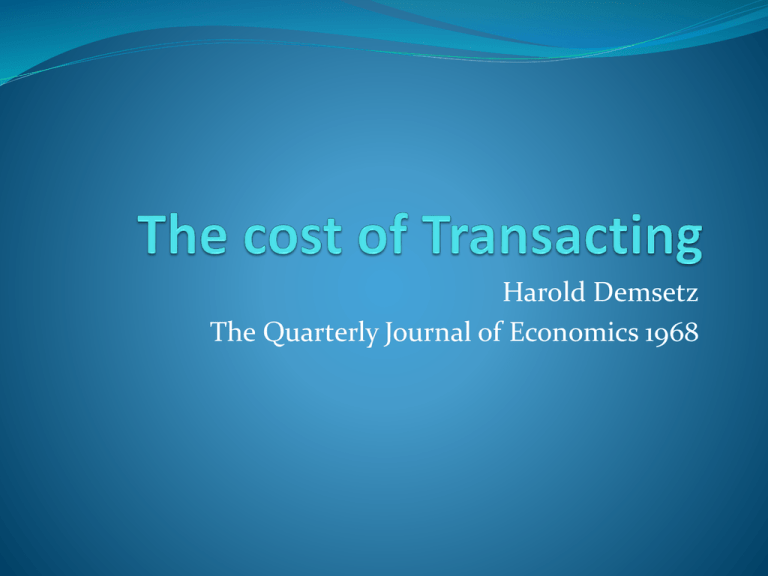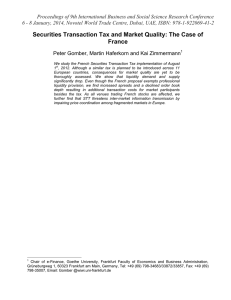Demsetz_QJE_1968.pptx
advertisement

Harold Demsetz The Quarterly Journal of Economics 1968 This paper… Studies the cost of transacting on the NYSE Examines the presence of scale economies in transacting Also investigates the effects of competing markets on the transacting costs The definition and measurement Transaction cost is defined narrowly as the cost of using the NYSE to accomplish a quick exchange of stock for money Brokerage fees and ask-bid spread The ask-bid spread is the markup that is paid for predictable immediacy of exchange The price of immediacy “Waiting costs would seem to dominate the determination of spread” (p41) Ask-bid spread and trading volume (Figure 1) Inactive and active security (i, a) The determinants of the ask-bid spread(1) The time rate of transactions Scale economies in a particular security: The greater the frequency of transacting, the lower will be the cost of waiting, and therefore the lower will be the spreads Scale economies with respect to the individual trader’s transaction(?): Individual trader’s marginal cost of transacting will decrease as the rate at which he transacts increases (conflicting evidence) The determinants of the ask-bid spread(2) Competition keep the observed spreads close to underlying costs Types of competition 1) Rivalry for the specialist’s job, 2) competing markets, 3) outsiders who submit limit orders, 4) floor traders who bypass the specialists, 5) other specialists Alternative interpretation on the relationship between the spread and the number of competing markets Securities listed on more exchanges may tend to be more actively traded Table 1 The determinants of the ask-bid spread(3) A security’s price Spread per share will increase in proportion to an increase in the price per share so as to equalize the cost of transacting per dollar exchanged Otherwise, those who submit limit orders will find it profitable to narrow spreads on those securities for which spread per dollar exchanged is larger It might not be strictly proportionate because of disproportionate brokerage commission The determination of the transaction rate Short-run transaction rate Short-lived rumor, an accidental convergence of trading in the stock or the overall market activity Measured as the number of transactions per day based on data for two (nonadjacent days of trading) Long-run transaction rate The number of persons presently owning shares will be positively related to the number of market participants Measured as the number of shareholders Variables and data Variables S=the ask-bid spread measured in dollars per share T=the number of transactions per day P=the price of per share N=the number of shareholders M=the number of markets on which the security is listed Data 200 securities listed on the NYSE Jan. 5 and Feb 28, 1965 Regressions Regression equations S=f(T, P, M) S=g(N, P, M) T=h(N) Expected sign (1) ST<0, (2) STT>0, (3) SP>0, (4)SN<0, (5)SNN>0 6) SPP<=0, (7) SM<=0 Statistical results All coefficients take on the expected signs and all except the M coefficient are highly significant Statistical results Transaction rate is determined primarily by the number of shareholders Summary The cost of exchanging a security declines as trading activity increases Centralized and organized exchanges would lower the transacting costs The markups required to market additional shares will be less for larger companies than for smaller companies ( differences in borrowing rates)


